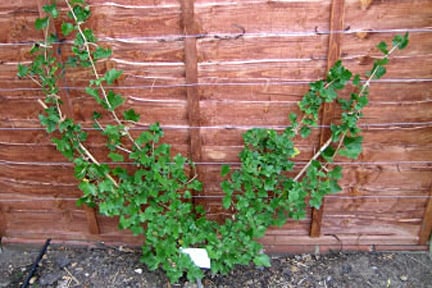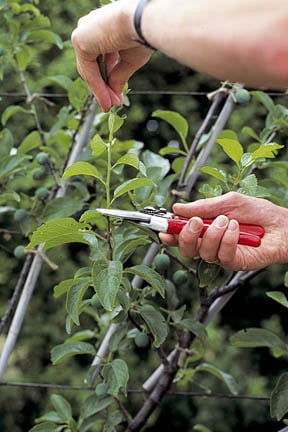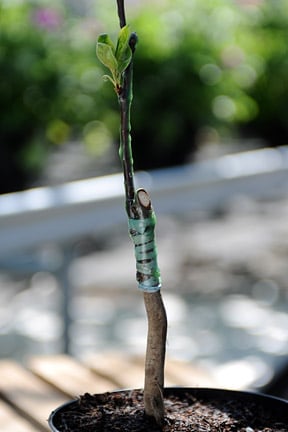
Quick facts
Suitable for - Almonds, apples, cherries, figs, peaches, pears, plums, nectarines and redcurrants
Timing - Summer
Difficulty - Moderate
Suitable for...
Fans are commonly used for stone fruits, which are not suitable for training as an espaliers or other restricted forms. There are a wide range of fruits that can be fan-trained, including:
Almonds, apples, cherries, figs, gooseberries, pears, peaches, nectarines, apricots, plums and redcurrants.
When to prune young fans
Spring is the best time to train trees as the pruning wounds heal quickly and the growth response is strong.
- Apples, pear, gooseberry and redcurrant fans can be trained in late winter/early spring before break
- Stone fruits should be trained in early to mid-spring to minimise the risk of fungal diseases, such as silver leaf
- Figs can be pruned in spring once the frosts have passed
With all fans, re-growth after spring-pruning should be managed through the summer. See our pruning established fans page for more details.
How to fan train a tree
Plant trees 15-22.5cm (6-9in) away from the wall or fence, sloping slightly towards it. When planting beneath walls, take care to avoid foundations, improve the poor soil often found there and ensure watering is adequate during dry spells.
Preparation and planting
1. For fan-training, choose semi-dwarfing or semi-vigorous rootstocks. The following are best choices available, depending on the size of the fan tree required:
- Apples: ‘M26’ 1.8m high by 3-3.6m wide (6ft by 10-12ft); ‘MM106’ 2m by 3.6-4.5m (6½ft by 12-14½ft); ‘MM111’ 2-2.4m by 4.5-5.5m (6½-8ft by 14½-17½ft)
- Pears: ‘Quince C’ 1.8m by 3.6m (6ft by 12ft) or ‘Quince A’ 2m by 3.6-4.5m (6½ft by 12-14½ft)
- Peach, nectarine, apricot: ‘St. Julien A’ 1.8-2m by 3.6-5m (6-6½ft by 12-16ft)
- Plum: ‘Pixy’ 2m by 4.5m (6½ft by 14½ft) or ‘St Julien A’ 2-2.4m by 4.5-5.5m (6½-8ft by 14½-17½ft)
- Acid cherry: ‘Colt’ 1.8-2m by 3.6-5m (6-6½ft by 12-16ft)
- Sweet cherry: ‘Gisela 5’ 1.8m by 3.6m (6ft by 12ft) or ‘Colt’ 2-2.4m by 5-5.5m (6½-8ft by 16-17½ft)
2. Choose a wall or fence of sufficient height – around 2m (6½ft) is suitable for most fans. A south or south-west facing wall or fence for most fruits; north-facing is acceptable for acid cherries, gooseberry and redcurrants.
Erect sturdy horizontal wires starting 40cm (15in) from the ground to train stems against. Horizontal wires should be 4-10cm (1½-4in) away from the wall and positioned 15cm (6in) apart – roughly two brick courses. Use 1.2mm galvanised wire. For long runs, attach wires to a straining system, such as straining bolts screwed into vine eyes with a nut to hold them in place
3. Choose either a (a one-year-old tree with no branches), a feathered maiden (with two branches suitably positioned to be the main arms of the fan) or a part-trained fan
4. Plant trees 15-22.5cm (6-9in) away from the wall or fence, sloping slightly towards it. When planting beneath walls, take care to avoid foundations, improve the poor soil often found there and ensure watering compensates for any rain shadow created by the wall
Pruning and training
Starting with an unfeathered maiden or whip (a one-year-old tree with no branches)
- In spring, cut back the main stem to about 40cm (15in), leaving three strong
- In summer, erect two canes at 45 degree angles and tie in two of the branches that should develop from the buds to form the ‘arms’ (one either side). Remove any other shoots if they develop from the trunk
- In the second spring, reduce the ‘arms’ by two-thirds to an upward-facing . Again, remove any other growth from the trunk
Starting with a feathered maiden (a one-year-old-tree with some branches) or untrained two-year-old tree
- In spring, cut back the main stem to about 40cm (15in) to two well-placed branches to form the main ‘arms’
- Erect two canes at 45 degrees and tie the two branches into them
- Now reduce each ‘arm’ by two-thirds to an upward-facing bud
Starting with a part-trained tree (commonly sold in garden centres, trained against a structure of canes)
- Part-trained trees will need their vertical, leading shoot removed; cut right down to strong, low, 45-degree-angled branches or ‘arms’. Leaving the leader will result in a congested bush, not a fan
- Now reduce all the ‘arms’ by two-thirds, if they are weak, less if they are strong and already branching
You should now have a short, balanced tree with two strong ‘arms’ (or possibly more in the case of a part-trained tree). Now follow these instructions to produce a fan:
- In summer, choose four shoots from each ‘arm’: one at the tip to extend the existing ‘arm’, two spaced equally on the upper side and one on the lower side. Tie them in at about 30 degrees to the main ‘arm’ so they are evenly spaced apart (using canes attached to the wires if necessary)
- Rub out any shoots growing towards the wall and pinch back any others to one leaf
- In the following spring, cut back each of the four branches on each side by one third, cutting to an upward-facing bud if possible
- During the growing season, tie re-growth from the tips of these branches into the framework to extend the main branches
- Any side-shoots that develop where there is space within the framework can be tied in
Future pruning of established fans varies according to the species.
Recommended reading
For more detailed pruning instructions try:
RHS Pruning and Training (Revised New Edition) by Christopher Brickell and David Joyce (Dorling Kindersley 2017, ISBN 9780241282908)
RHS Fruit by Harry Baker (Mitchell Beazley 1995, ISBN 9781857329056)
The Fruit Garden Displayed by Harry Baker (RHS 1991, ISBN 9780304340163)
These books are also available through the RHS Lindley Library.





